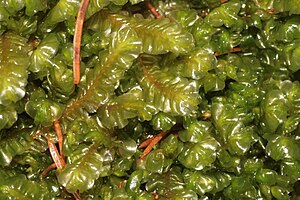Plagiochila asplenioides
| Plagiochila asplenioides | ||||||||||||
|---|---|---|---|---|---|---|---|---|---|---|---|---|

Plagiochila asplenioides |
||||||||||||
| Systematics | ||||||||||||
|
||||||||||||
| Scientific name | ||||||||||||
| Plagiochila asplenioides | ||||||||||||
| ( L. ) Dumort. |
Plagiochila asplenioides is aspecies of liverwort from the Plagiochilaceae family . German-language names are Großes Schiefmundmoos and Großes Muschelmoos . This species hasonly been systematically separatedfrom the very similar Plagiochila porelloides since around 1980.
features
Plagiochila asplenioides is one of the most impressive representatives of the leafy liverwort in Central Europe. The very vigorous to vigorous plants have little or no branching, are up to 12 centimeters long and 5 to 9 millimeters wide, grow up to almost upright and form lush light to dark green lawns or grow sporadically between other mosses. They show a certain resemblance to a small striped fern ( Asplenium , name). The flank leaves that run down the top of the trunk are oval to obovate with a broadly rounded tip, asymmetrical, transversely curved and often shell-shaped and hollow. They are 2.5 to 4.2 millimeters long and 2.0 to 4.2 millimeters wide. The leaf margin is usually toothed small, rarely almost entire. Lower leaves are very small or absent entirely.
Leaf cells are rounded-hexagonal, 32 to 48 µm in size in the middle of the leaf, thin-walled, with slightly thickened cell corners. There are 4 to 10 oil bodies per cell , they are spherical, oval or grape-shaped.
Like the other species of the genus, Plagiochila asplenioides is dioecious . Perianthia are very seldom formed, they protrude far from the bracts, are up to 1 centimeter in size, flattened at the top and have a thorny, toothed mouth. Spore capsules are oval, 70 to 80 µm thick, the smooth spores are 16 to 18 µm in size. Spore ripening is in spring.
ecology
Plagiochila asplenioides grows on fresh to wet, mostly shaded, nutrient-rich, lime-poor to base-rich and humus-rich locations, especially on the ground and on slopes in forests, also in swelling places in riparian forests, less often on the bottom of trees, on rotten wood or humus-rich rocks. It is often rare on the plains, but widespread or often in the mountains, where it rises up to the subalpine altitude.
distribution
The species is widespread in Europe, except in the far north. In southern Europe it occurs only in the mountains. Outside of Europe there are occurrences in western Asia and North America.
literature
- Jan-Peter Frahm , Wolfgang Frey , J. Döring: Moosflora . 4th edition, UTB Verlag, 2004, ISBN 3-8252-1250-5
- Ruprecht Düll , Barbara Düll-Wunder: Determine mosses easily and reliably . Quelle & Meyer Verlag Wiebelsheim, 2008, ISBN 978-3-494-01427-2
- Nebel, Philippi: Die Moose Baden-Württemberg Volume 3 . 1st edition, Ulmer Verlag, 2005, ISBN 3-8001-3278-8